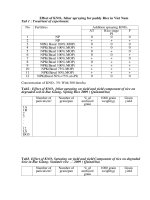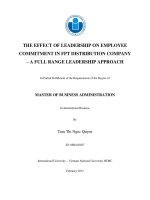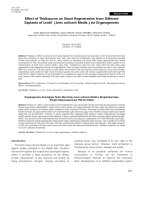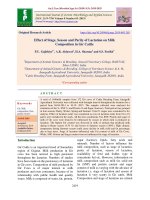Effect of stage, season and parity of lactation on milk composition in Gir cattle
Bạn đang xem bản rút gọn của tài liệu. Xem và tải ngay bản đầy đủ của tài liệu tại đây (247.77 KB, 7 trang )
Int.J.Curr.Microbiol.App.Sci (2019) 8(3): 2419-2425
International Journal of Current Microbiology and Applied Sciences
ISSN: 2319-7706 Volume 8 Number 03 (2019)
Journal homepage:
Original Research Article
/>
Effect of Stage, Season and Parity of Lactation on Milk
Composition in Gir Cattle
P.U. Gajbhiye1*, A.R. Ahlawat2, H.A. Sharma2 and S.S. Parikh3
1
Department of Animal Genetics & Breeding, Arawali Veterinary College, RAJUVAS,
Sikar-332001, India
2
Department of Animal Genetics & Breeding, College of Veterinary Science & A. H.,
Junagadh Agricultural University, Junagadh-362001, India
3
Cattle Breeding Farm, Junagadh Agricultural University, Junagadh-362001, India
*Corresponding author
ABSTRACT
Keywords
Gir, Milk
composition, Nongenetic factors
Article Info
Accepted:
20 February 2019
Available Online:
10 March 2019
A total of 1649milk samples from 172 Gir cows of Cattle Breeding Farm, Junagadh
Agricultural University were collected with fortnight interval throughout the lactation for a
period from 04-04-2014 to 10-10 -2015. The samples collected were analyzed for
estimation of Fat %, SNF %, and Protein % and Sugar (Lactose). Total period was grouped
in four seasons: Rainy, Winter, Spring and Summer. Total 11 stages were considered to for
analysis. Effect of lactation order was considered as cows in lactation order from 01 to 10
parity were included in the study. All the four constituents, Fat, SNF, Protein and sugar of
milk of Gir cows were found to be influenced by season in which milk is produced in
lactation. The highest Fat content was observed in milk of animals that produced milk
during in Rainy season (4.34 %) and lowest in Summer season (3.88%). High climatic
temperature during Summer season could cause decline in milk yield and fat percentage
due to heat stress. Stage of lactation influenced only Fat content of milk of Gir Cows.
While, SNF, Protein and Sugar content were not influenced by stage of lactation.
Introduction
Gir Cattle is an important breed of Saurashtra
region of Gujarat. Milk production in Gir
cows has been noticed as high persistent
throughout the lactation. Numbers of studies
have been made on the persistency of lactation
in Gir cows. Composition of milk produced by
Gir Cows is of major interest to milk
producers and even consumers, because of its
relationship with public health and quality
issues. Milk is composed of water, fat, protein,
sugar (lactose), lipids, fatty acids and
minerals. Number of factors influence the
milk composition, such as stage of lactation,
parity of lactation, season of lactation,
availability of feed and fodder, type of
concentrate fed etc. However, information on
milk composition such as milk fat, solid not
fat (SNP) and protein content and sugar
content of milk as varying with the advance of
lactation i.e. stage of lactation and season of
lactation is very scanty in Gir cattle. Milk
Composition and stage of lactation are related
2419
Int.J.Curr.Microbiol.App.Sci (2019) 8(3): 2419-2425
(Looper, M. 2016; Kayastha et al., 2008;
Arora and Bhojak, 2013). Variation in milk fat
and protein due to advancement of lactation
has been reported by Rogers and Stewart
(1982). Similar Information in milk of Gir
cattle is scanty. Hence, study was carried out
to assess the causes of fluctuation in
composition of milk.
Materials and Methods
A total of 1649milk samples from172
individual Gir cows of Cattle Breeding Farm,
Junagadh Agricultural University were
collected with fortnight interval throughout
the lactation for a period from 04-04-2014 to
10-10 -2015. The samples collected were
analyzed using Lactoscan milk Analyzer for
estimation of Fat %, SNF %, and Protein %
and Sugar (Lactose). Uniform feeding regime
was followed throughout the experimental
period in the entire Gir herd. Seasonal
variation in the feed & fodder supplied were
considered towards effect season on the milk
constituents. Total period was grouped in four
seasons: Rainy (July-Sept), Winter (Oct-Dec),
Spring (Jan-Mar) and Summer (April-June).
Stage of lactation was taken as month of
lactation from calving to drying in which milk
sample was taken. Total 11 stages were
considered to for analysis. Effect of lactation
order was considered as cows in lactation
order from 01 to 10 parity were included in
the study.
Fat %, SNF %, Protein % and Lactose % for
each milk sample on monthly interval of each
individual animal throughout lactation period.
The data collected were analyzed for assessing
the effect of stage of lactation, season of
lactation (Season in which sample were taken)
and order of lactation using Least-squares
analysis (Harvey, 1987). The data were
subjected to square root transformation for
statistical analysis.
Results and Discussion
Season in which sample of milk in a lactation
was taken found to influence milk composition
in terms of Fat, SNF, CP and Sugar highly
Significantly (P < 0.01). This could be due to
the effect of seasonal variation in the feed and
fodder supply during the year along with the
effect of climate on the body physiology. High
climatic temperature observed during Summer
season could decline in milk yield and fat
percentage. Bandarnayaka and Holmes (1976)
reported that fat percentage decreased in the
heat stressed cows compared to control.
Fat content in the milk produced in all the four
Season of sampling differ highly significantly
(P < 0.01). The highest Fat being produced in
the season – July-Aug-Sept (Rainy cum
winter) and lowest in April-May-June
(Summer season). Season x Stage of lactation
interaction was found to be non-significant.
Similar significant (P<0.01) variation in Fat
content of milk due to Season was also
reported by Jenness, (1985). Seasonal
variations in milk fat percentage are well
recognized with Summer months averaging
0.4 percentage unit less than Winter months.
Stage and Parity of lactation was also found to
affect the fat content of the milk (P<0.05).A
decrease in milk fat percentage of 0.2 percent
over five lactations has been reported by
Rogers and Stewart (1982). They also
observed that milk fat percentage vary with
stage of lactation. The highest percentages are
usually found in Colostrum, followed by a
decline during first 2 months of lactation, then
a slow increase as the lactation progress.
Significant effect of stage of lactation on fat
percentage was reported by Kayastha et al.,
(2008) in Assam cattle. Bhoite and Padekar
(2002) reported non-significant effect of stage
of lactation on Fat in HF crosses but
significant effect in crosses involving Jersey
(Table 1 and 2; Fig. 1–3).
2420
Int.J.Curr.Microbiol.App.Sci (2019) 8(3): 2419-2425
Table 1 Effect of lactation order was considered as cows in lactation order from 01 to 10 parity
Stage of Lactation (Days)
0– 30
31– 60
61– 90
91– 120
121– 150
151– 180
181– 210
211– 240
241 – 270
271 – 300
>300
Stage
01
02
03
04
05
06
07
08
09
10
11
Table.2 Least-squares averages for Fat, SNF, Protein and Sugar in milk of Gir Cattle
Season wise means for FAT, SNF, Protein, Sugar
Effects
Overall Mean
Rainy
Winter
Spring
Summer
N
1649
439
356
230
624
FAT
4.157
4.343
4.264
4.145
3.884
SNF
8.856
9.150
8.856
8.803
8.637
Protein
3.283
3.396
3.279
3.214
3.250
Sugar
4.831
5.040
4.835
4.734
4.717
Stage wise means for FAT, SNF, Protein, Sugar
Effects
N
FAT
SNF
Protein
Sugar
Stage 1(0-30 days)
Stage 2(31-60 days)
185
196
4.141
4.040
8.856
8.910
3.294
3.286
4.857
4.778
Stage 3(61-90 days)
Stage 4(91-120 days)
178
172
4.056
4.120
8.755
9.138
3.279
3.272
4.818
4.84
Stage 5(121-150 days)
Stage 6(151-180 days)
149
134
4.223
4.186
9.284
8.850
3.312
3.276
4.915
4.866
Stage 7(181-210 days)
Stage 8(211-240 days)
124
106
4.251
4.129
8.862
8.590
3.323
3.196
4.892
4.761
Stage 9(241-270 days)
Stage 10(271-300 days)
Stage 11 (>300 days)
67
72
266
3.932
4.347
4.313
8.503
8.773
8.946
3.236
3.326
3.326
4.652
4.870
4.888
2421
Int.J.Curr.Microbiol.App.Sci (2019) 8(3): 2419-2425
Parity wise means for FAT, SNF, Protein, Sugar
Effects
Parity 1
Parity 2
Parity 3
Parity 4
Parity 5
Parity 6
Parity 7
Parity 8
Parity 9
Parity 10
N
468
441
229
229
127
58
51
28
17
01
FAT
3.996
4.040
4.032
3.873
4.182
3.908
4.276
3.869
4.116
5.382
SNF
8.749
8.785
8.743
8.602
9.000
9.162
8.880
8.928
8.323
9.603
Protein
3.229
3.268
3.243
3.186
3.334
3.186
3.286
3.345
2.941
3.478
Sugar
4.796
4.791
4.787
4.635
4.870
4.743
4.937
4.853
4.635
5.29
ANOVA for Fat, SNF, Protein and Sugar content in Gir milk
Effect
Season
Stage
Parity
SeasonXStage
Remainder
d.f.
3
10
9
30
1596
MS-Fat
1.052901**
0.094653*
0.091583*
0.065471
0.045088
MS-SNF
0.513890**
0.133922
0.068559
0.147786*
0.089150
MS-Protein MS-Sugar
0.149378* 0.394239**
0.012362
0.22798
0.038020
0.039650
0.024975
0.033690
0.041951
0.021836*
*<0.05, **<0.01
Fig.1 Season wise variation in FAT, SNF, Protein and sugar
10.00
9.15
8.86
9.00
8.80
8.64
8.00
7.00
6.00
5.00
4.00
5.04
4.34
4.84
4.26
3.40
4.73
4.15
3.28
4.72
SNF
3.88
3.21
FAT
3.25
3.00
PROTEIN
SUGAR
2.00
1.00
0.00
July - Aug - Oct - Nov - Dec Jan - Feb - Mar Apr - May - Jun
Sep
2422
Int.J.Curr.Microbiol.App.Sci (2019) 8(3): 2419-2425
Fig.2 Stage wise variation in FAT, SNF, Protein and sugar
25.00
20.00
15.00
4.86
4.78
4.82
4.84
4.92
3.29
3.29
3.28
3.27
8.86
8.91
8.76
9.14
4.87
4.89
4.76
4.65
3.31
3.28
3.32
3.20
3.24
9.28
8.85
8.86
8.59
8.50
4.87
4.89
3.33
3.33
8.77
8.95
SUGAR
10.00
PROTEI
N
5.00
4.14
4.04
4.06
4.12
4.22
4.19
4.25
4.13
3.93
4.35
4.31
0.00
Stage Stage Stage Stage Stage Stage Stage Stage Stage Stage Stage
1
2
3
4
5
6
7
8
9
10
11
Fig.3 Parity wise variation in FAT, SNF, Protein and sugar
25.00
5.29
20.00
4.80
4.79
4.79
4.87
4.64
4.74
4.94
4.85
4.64
3.48
15.00
3.23
8.75
3.27
8.79
3.24
8.74
3.19
8.60
3.33
9.00
3.19
9.16
3.29
8.88
3.35
8.93
2.94
9.60
SUGAR
PROTEI
N
SNF
8.32
10.00
FAT
5.38
5.00
4.00
4.04
4.03
3.87
4.18
3.91
4.28
3.87
4.12
0.00
Parity Parity Parity Parity Parity Parity Parity Parity Parity Parity
1
2
3
4
5
6
7
8
9
10
2423
Int.J.Curr.Microbiol.App.Sci (2019) 8(3): 2419-2425
Sarkar (2006) reported that lactation stage had
no influence on fat content of milk.
SNF content in the milk of Gir Cows differ
highly significantly (P < 0.01) in all the four
season of sampling, the highest SNF being
observed in the season - July to Sept and
Lowest in April- June.
Effect of Stage of lactation and Parity was
found to be non-significant on SNF content of
milk. Sarkar (2006) observed significant
effect of lactation stage on SNF, Protien and
Lactose content of milk. However, Kayastha
et al., (2008) reported significant effect of
Stage of lactation on SNF content in Assam
Cattle. However, Season and Stage of
lactation interaction effect was found to be
significant on SNF.
Milk Protein and milk sugar content in the
milk of Gir cows differ highly significantly
(P<0.01) in all the four season of sampling.
This was also reported by Jenness (1985),
Rogers and Stewart (1982). They observed
that age of animal has a significant effect on
milk protein percentage and composition in
cows.
Influence of Stage of lactation and Parity of
lactation was found to be non-significant on
Protein and Sugar content of milk. The main
biological function of Lactose in milk is the
regulation of water content and thus the
regulation of osmotic content (Davis et al.,
1983; Jenness, 1985).
Because of this function Lactose remains the
most constant constituent in milk. Nonsignificant influence of stage of lactation on
milk protein was reported by Kayastha et al.,
(2008) in Assam Cattle.
Interaction effect of Season and Stage was
marginal significant (P<0.05) for sugar and
non- significant for protein.
All the four constituents, Fat, SNF, Protein
and sugar of milk of Gir cows were found to
be influenced by season in which milk is
produced in lactation. Seasonal variation in
the feed and fodder supply during the year
along with the effect of environment on the
body physiology during lactation period could
be responsible factors affecting milk
composition. The highest Fat content was
observed in milk of animals that produced
milk during July-Sept. (4.34 %) i.e. in Rainy
season and lowest in the April-June. (3.88%)
i.e. in Summer. High climatic temperature
observed during Summer season could cause
decline in milk yield and fat percentage due to
heat stress. Stage of lactation was found to
influence only Fat content of milk of Gir
Cows. While, SNF, Protein and Sugar content
were not influenced by stage of lactation.
References
Arora, R. and Bhojak, N. 2013.
Physiochemical and Environmental
factors responsible for change in milk
composition of milking animals. Int J
Engg Sci, 2(1): 275-277.
Bandaranayaka, D. D. and Holmes, C. W.
1976. Changes in the composition of
milk and rumen contents in cows
exposed to a high ambient temperature
with controlled feeding. Trop Anim.
Health Prod, 8: 38-46.
Bhoite, U.Y. and Padekar, R. N. 2002.
Factors affecting milk yield and
composition. Ind J AnimRes, 36: 67-69.
Harvey, W. R. 1987. Mixed model least
squares and Maximum likelihood
computer program– Iversion, USDA,
Washington, USA.
Jennes, R. 1985. Biochemical and nutritional
aspects of milk and colostrum. Chap. 5
in Lactation, B. L. Larson, editor, ed.
Ames: Iowa State University Press.
Kayastha, R. B., Zaman, G. and Goswami, R.
N. 2008. Factors affecting the milk
2424
Int.J.Curr.Microbiol.App.Sci (2019) 8(3): 2419-2425
constituents of native cattle of Assam.
Ind J AnimRes, 42(2): 270-272.
Looper, M. 2016. Factors affecting milk
composition of lactating cows. Agri
Natural Res. (downloaded from
/>FSA-4014.pdf)
Rogers, G. L. and Stewart, J. A. 1982. The
effect of some nutritional and non-
nutritional
on
milk
protein
concentration and yield. Aust JDairy
Tech, 37: 26.
Sarkar, U., Gupta, A. K., Sarkar, V, Mohanty,
T. K., Raina, V. S. and Prasad, S. 2006.
Factors affecting test day milk yield and
milk composition in dairy animals. J
Dairying, Food Home Sci, 25: 129-132.
How to cite this article:
Gajbhiye, P.U., A.R. Ahlawat, H.A. Sharma and Parikh, S.S. 2019. Effect of Stage, Season and
Parity of Lactation on Milk Composition in Gir Cattle. Int.J.Curr.Microbiol.App.Sci. 8(03):
2419-2425. doi: />
2425









